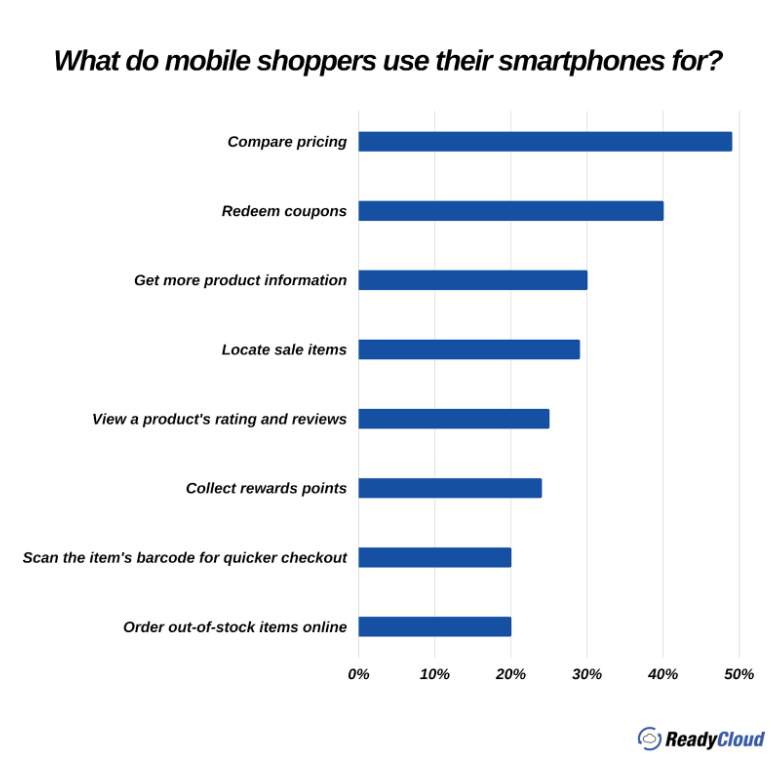A Cavalcade of MCommerce Statistics for the Cross-Channel Seller in 2022

With more than seven billion mobile phone users in the world, it should come as no surprise that mobile commerce (or mcommerce) accounts for a huge piece of the ecommerce pie. Smartphones offer the same convenience as other devices, but consumers can make purchases while on the go. And the ubiquity of smartphones means the opportunities to sell are nearly endless — especially for cross-channel sellers.
Cross-channel selling is a strategy many savvy e-tailers have adopted in recent years because it provides a better customer experience and a simpler way to organize customer data. For customers, cross-channel retailing lets them discover products where they’re already shopping and then purchase without having to start over at every touchpoint. For sellers, it aggregates their integrations and customer base into a streamlined back end for smoother operations.
There’s no doubt that cross-channel sellers are smart to meet customers where they spend their time, but to truly maximize their total addressable market, they also have to consider the opportunities of mobile. Here’s a whole cavalcade of mcommerce statistics for 2022 that prove it.
U.S. retail mcommerce sales are forecasted to reach $710 billion by 2025. (Source)
2021 saw sales surpass $360 billion in 2021, and the figure is on track to nearly double in just a few years.
Mcommerce generates 41% of ecommerce sales. (Source)
The percentage is projected to climb to 46% by 2025, so sellers will effectively miss out on half of their sales opportunities if they don’t incorporate mobile.
There are 178 million mobile shoppers in the U.S. alone. (Source)
178 million is nothing to sniff at. That’s a huge market, and 15% of those consumers don’t have regular access to desktop computers or laptops to make their purchases.
60% of online searches come from mobile devices. (Source)
Whether consumers prefer Google, Bing or DuckDuckGo, they’re using their phones more often than their desktops to search online.
Smartphones account for 69% of ecommerce website visits. (Source)
However, smartphones generated only 60% of purchases. Desktop devices, on the other hand, accounted for 28% of traffic and 38% of orders.
24% of the top one million most popular sites are not mobile-friendly. (Source)
In the famous study by Canonicalized, it was revealed that almost one-quarter of the world’s most popular websites are not optimized for mobile users. Your online store might not rank in the top one million sites on the entire web, but there’s still a major opportunity to capture mcommerce shoppers.
Half of mcommerce consumers downloaded a shopping app before the 2021 holiday season. (Source)
Shopping apps are often more intuitive and mobile-friendly than even the best mobile-optimized websites, so of course consumers flock to them before the biggest spending season of the year. And it’s not just the ecommerce behemoths that have apps — brands like Sephora, Chewy and Best Buy let customers browse and buy through their mobile apps.
85% say they prefer shopping apps to mobile websites. (Source)
The holiday season isn’t the only time shopping apps are popular. In fact, they’re on the rise, with the most used ones racking up billions of users.
Walmart recently surpassed Amazon as the most popular shopping app. (Source)
The Walmart app saw a staggering 25 billion user sessions in 2021, whereas Amazon Shopping recorded 23 billion sessions. SHEIN’s and eBay’s apps trailed far behind with 2.4 billion and 2.1 billion, respectively.
U.S. consumers spent 100 billion hours in Android shopping apps in 2021. (Source)
All these users are certainly spending significant time browsing and buying within these apps.
49% of mobile users compare pricing on their phones. (Source)
Research from Criteo shows people use their smartphones to compare prices of goods and services, redeem coupons (40%) and research products (30%). Therefore, many of your prospective customers are seeing your website for the first time from their phones, so it’s crucial to make a good first impression.

57% of shoppers will not recommend an online store with a poor mobile experience. (Source)
Here’s further proof that your mobile commerce customer experience is key.
The average mcommerce conversion rate is 2%. (Source)
Ecommerce conversion rates are down about 8% globally, with mcommerce conversions hovering around 2% throughout 2022. Desktop and tablet conversions are slightly higher at 3% each.
The average order value on mobile is $112.29. (Source)
This figure has been steadily climbing since Q3 of 2021, but it still trails behind desktop AOV at $155.75.
Two-thirds of mobile shoppers say small, hard-to-click links are a barrier to purchasing. (Source)
Smartphones are oh-so-convenient for shopping anywhere and at any time, but plenty of mcommerce sites have a frustrating user experience with small pages and links that are hard to click.
Mobile users are 31% more likely to make a purchase on a larger screen. (Source)
Here’s the parallel between movies and online shopping: Sometimes it’s just better on the big screen. That’s why smartphone users are more likely to buy when their devices have larger screens. Now that you’ve seen the mcommerce statistic above, is this really a surprise?
42% of consumers cite security concerns as an obstacle to mcommerce. (Source)
Cybersecurity is (rightfully) a top priority for today’s consumers, and at least four in ten don’t feel safe shopping online from their phones. Consider adding security badges to your site to assure shoppers that their payments and data are safe with your business.
Here are the other obstacles shoppers cited:
- Messages and other interruptions from apps (36%)
- Difficulty finding items they’re looking for (36%)
43.9 million American shoppers use Apple Pay. (Source)
Smartphones aren’t just for shopping in the mcommerce world. Mobile payments and wallets fall into this category, with Apple Pay leading the charge. Starbucks Pay comes in second with 31.2 million users and Google Pay in third with 25.2 million users.
Mobile wallet payments account for 49% of global transactions. (Source)
Far from a passing trend, mobile wallets are gaining popularity and will account for 53% of purchases by 2025.
Mobile commerce sales through social media will surpass $100 billion by 2023. (Source)
Social commerce grew more quickly than even industry experts expected, with 37.9% growth year over year between 2020 and 2021. This is largely related to the pandemic and the explosion of TikTok, which presented a lucrative opportunity for e-tailers who stuck while the iron was hot.
Wrapping Up
Mobile commerce isn’t going anywhere, especially considering the rise of shopping apps, mobile wallets, and social commerce. The reality is consumers’ phones are an integral part of their lives, so cross-channel sellers need to tap into the mobile market to stay relevant.
For more ecommerce trends to keep your online store ahead of the competition, check out our recent guide.

Share On:








